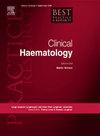Immune reconstitution following allogeneic hematopoietic cell transplantation and CAR-T therapy: dynamics, determinants, and directions
IF 2
4区 医学
Q3 HEMATOLOGY
引用次数: 0
Abstract
Immune reconstitution (IR) is a dynamic and sequential process that occurs after allogeneic hematopoietic cell transplantation (allo-HCT) and cellular therapies, involving the gradual recovery of both innate and adaptive immune compartments. The success of IR is a critical determinant of clinical outcomes, including the risk of graft-versus-host disease and graft-versus-leukemia effects. In the context of allo-HCT, IR shaped by various factors, including transplantation modalities, conditioning regimens, therapeutic interventions, and post-transplant strategies. The kinetics and quality of IR following chimeric antigen receptor T-cell (CAR-T) therapy are also shaped by several factors, such as lymphodepleting chemotherapy, CAR construct design, and the patient's baseline immune status. In particular, B-cell–targeted CAR-T therapy frequently results in B-cell aplasia, hypogammaglobulinemia, and immune exhaustion, necessitating improved monitoring and post-treatment interventions. These immunologic effects highlight the need for improved post-treatment monitoring and supportive interventions to reduce infection risk and ensure sustained immune recovery. To better characterize IR across both allo-HCT and CAR-T settings, advanced immune profiling technologies, such as flow cytometry and single-cell RNA sequencing, are providing new insights into the dynamics of immune recovery. Here, we summarize current knowledge on IR kinetics and evaluate the impact of different transplant and CAR-T settings. We then discuss personalized strategies to optimize immune monitoring and therapeutic approaches for recipients of allo-HCT and CAR-T therapies.
同种异体造血细胞移植和CAR-T治疗后的免疫重建:动力学、决定因素和方向
免疫重建(IR)是异基因造血细胞移植和细胞治疗后发生的一个动态和连续的过程,涉及先天和适应性免疫室的逐渐恢复。IR的成功是临床结果的关键决定因素,包括移植物抗宿主病和移植物抗白血病效应的风险。在同种异体hct的背景下,IR受多种因素影响,包括移植方式、调理方案、治疗干预和移植后策略。嵌合抗原受体t细胞(CAR- t)治疗后IR的动力学和质量也受到几个因素的影响,如淋巴细胞消耗化疗、CAR结构设计和患者的基线免疫状态。特别是,b细胞靶向CAR-T治疗经常导致b细胞发育不全、低γ -球蛋白血症和免疫衰竭,需要改进监测和治疗后干预。这些免疫效应强调需要改进治疗后监测和支持性干预措施,以降低感染风险并确保持续的免疫恢复。为了更好地表征同种异体hct和CAR-T环境下的IR,先进的免疫分析技术,如流式细胞术和单细胞RNA测序,正在为免疫恢复的动态提供新的见解。在这里,我们总结了目前关于IR动力学的知识,并评估了不同移植和CAR-T设置的影响。然后,我们讨论个性化的策略,以优化免疫监测和治疗方法,为接受同种异体hct和CAR-T治疗。
本文章由计算机程序翻译,如有差异,请以英文原文为准。
求助全文
约1分钟内获得全文
求助全文
来源期刊
CiteScore
4.20
自引率
0.00%
发文量
42
审稿时长
35 days
期刊介绍:
Best Practice & Research Clinical Haematology publishes review articles integrating the results from the latest original research articles into practical, evidence-based review articles. These articles seek to address the key clinical issues of diagnosis, treatment and patient management. Each issue follows a problem-orientated approach which focuses on the key questions to be addressed, clearly defining what is known and not known, covering the spectrum of clinical and laboratory haematological practice and research. Although most reviews are invited, the Editor welcomes suggestions from potential authors.

 求助内容:
求助内容: 应助结果提醒方式:
应助结果提醒方式:


